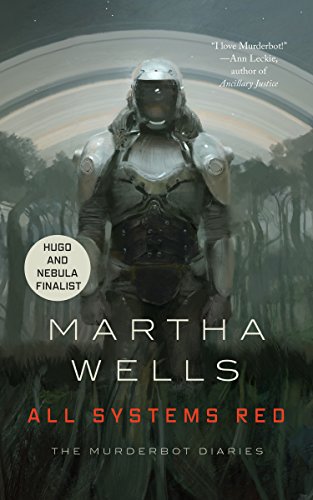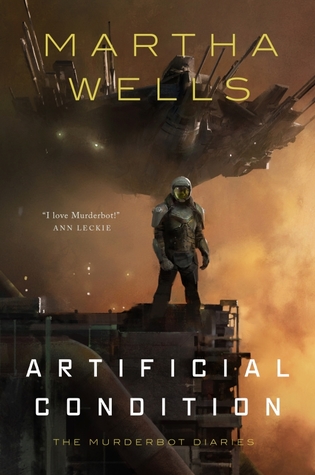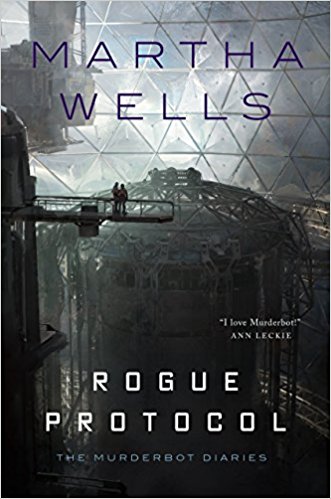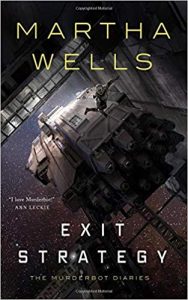 All Systems Red (The Murderbot Diaries #1) by Martha Wells
All Systems Red (The Murderbot Diaries #1) by Martha WellsFormat read: ebook purchased from Amazon
Formats available: hardcover, paperback, ebook, audiobook
Genre: science fiction
Series: Murderbot Diaries #1
Pages: 144
Published by Tor.com on May 2nd 2017
Purchasing Info: Author’s Website, Publisher’s Website, Amazon, Barnes & Noble, Kobo, Book Depository
Goodreads
In a corporate-dominated spacefaring future, planetary missions must be approved and supplied by the Company. Exploratory teams are accompanied by Company-supplied security androids, for their own safety.
But in a society where contracts are awarded to the lowest bidder, safety isn’t a primary concern.
On a distant planet, a team of scientists are conducting surface tests, shadowed by their Company-supplied ‘droid — a self-aware SecUnit that has hacked its own governor module, and refers to itself (though never out loud) as “Murderbot.” Scornful of humans, all it really wants is to be left alone long enough to figure out who it is.
But when a neighboring mission goes dark, it’s up to the scientists and their Murderbot to get to the truth.
 Artificial Condition (The Murderbot Diaries #2) by Martha Wells
Artificial Condition (The Murderbot Diaries #2) by Martha WellsFormat read: ebook purchased from Amazon
Formats available: hardcover, ebook, audiobook
Genre: science fiction
Series: Murderbot Diaries #2
Pages: 158
Published by Tor.com on May 8th 2018
Purchasing Info: Author’s Website, Publisher’s Website, Amazon, Barnes & Noble, Kobo, Book Depository
Goodreads
It has a dark past – one in which a number of humans were killed. A past that caused it to christen itself “Murderbot”. But it has only vague memories of the massacre that spawned that title, and it wants to know more.
Teaming up with a Research Transport vessel named ART (you don’t want to know what the “A” stands for), Murderbot heads to the mining facility where it went rogue.
What it discovers will forever change the way it thinks…
 Rogue Protocol (The Murderbot Diaries #3) by Martha Wells
Rogue Protocol (The Murderbot Diaries #3) by Martha WellsFormat read: ebook purchased from Amazon
Formats available: hardcover, ebook, audiobook
Genre: science fiction
Series: Murderbot Diaries #3
Pages: 158
Published by Tor.com on August 7th 2018
Purchasing Info: Author’s Website, Publisher’s Website, Amazon, Barnes & Noble, Kobo, Book Depository
Goodreads
SciFi’s favorite antisocial A.I. is again on a mission. The case against the too-big-to-fail GrayCris Corporation is floundering, and more importantly, authorities are beginning to ask more questions about where Dr. Mensah’s SecUnit is.
And Murderbot would rather those questions went away. For good.
Our Review:
Marlene: I read the first three Murderbot books in a binge one day. I was looking for something a bit different, I was still very much on an SF kick after WorldCon, and I thought, “what the hell, they’re short”. I did not expect to gobble them up one right after the other, and now they are all in a heap in my head, hence the multiple book review. That Galen had read them all in a heap just a couple of days before had absolutely no influence whatsoever on my decision to take the plunge. That’s my story and I’m sticking to it.
Galen: I blame, of course, thousands of people, starting first with Hugo Gernsback. The Murderbot series hadn’t really impinged on my consciousness prior to the the Tor.com/TorBooks upcoming releases panel at WorldCon, where they mentioned the upcoming release of Exit Strategy (which Marlene and I also read; review will come closer to its publication). What sealed the deal, however, was seeing Martha Wells walking up to the stage the night of the Hugo Award ceremony to accept a rocket for All Systems Red. Hundreds of Hugo voters can’t be wrong, right? Well sometimes… but not that day!
Marlene: According to Jo Walton’s An Informal History of the Hugos, the voters get it wrong about 30% of the time – but this definitely wasn’t one of those times.
This story is told in the first person singular, in Murderbot’s very singular voice. I’m going to use “it” to refer to Murderbot, because Murderbot has no gender – and is very specific on multiple occasions that it doesn’t need one, doesn’t want one, and wouldn’t have one at gunpoint. As a being who has been forced to observe human behavior in all its messy minutiae for days of tedium upon end, Murderbot sees gender as one of our many, many useless attributes.
Galen: Murderbot’s voice carries the series. But who is Murderbot? It is a SecUnit: a construct combining machine parts and human-derived tissues with both a human nervous system and artificial intelligence. Oh, and lots of built-in weapons — and security protocols and expertise bar none. (One of the reasons Murderbot is not a far-future Pinocchio? It rightly judges that most humans are pretty rubbish as security units.)
In other words, SecUnits are dangerous and most humans find them unnerving. Like many SecUnits, Murderbot gets rented out by the corporation that owns it to provide security; in Muderbot’s case, for a small planetary survey team — and one SecUnit suffices. What keeps SecUnits from running amok? A governor unit… which Murderbot has disabled, making it its own construct. Freeing it to…. watch hours and hours of bad sci fi soap operas when it’s not on duty.
Marlene: Murderbot may be a bit more “human” than it would like to think. Spending its downtime watching (and re-watching) bad sci fi soap operas strikes this reader as a sign of the humanity that Murderbot would disavow rather strenuously.
But speaking of Murderbot, it named itself that. SecUnits don’t have individual names, and if they have individual numbers or unit designations we don’t see that. By hacking its governor unit, Murderbot has given itself free will, although it could be argued that it would have needed at least some free will to decide to hack its governor unit in the first place!
However, it knows that if anyone in authority discovers its hack, it will be forcibly re-governed – or just stripped for parts. So part of its internal commentary is about its necessity to keep its freedom a secret at all costs – and the way that freedom conflicts with its programming to keep its clients alive.
As Galen said above, Murderbot is certain that humans are rubbish as security units. In fact, it thinks humans are rubbish at dealing with security issues at all. It’s always seen a part of its job as doing its best to prevent its human clients from doing stupid things and endangering themselves against its instructions. Now that it has free will, it has to constantly weigh how active it should be in preventing that stupidity.
The more I talk about Murderbot’s free will, the more it reminds me of Shale the golem in Dragon Age Origins, who also has unexpected free will after her (she does discover she has gender after all) controller rod is irretrievably broken. Without those years of watching bad broadcast melodrama, Shale has much less feeling for the other members of her party than Murderbot does for at least some of its clients. Just as TV has often been used by immigrants to learn the language of their new country, Murderbot has also used entertainment media to learn the language of what is effectively its new country, the world of self-willed, independent-thinking augmented humans. Murderbot is just a bit more augmented than most.
But we should probably get back to the books themselves, shouldn’t we?
Galen: As I mentioned, in All Systems Red Murderbot finds itself on a contract to provide security for the PreservationAux team doing a planetary survey. While some of the local wildlife are indeed looking for a light lunch of Dr. Mensah and her folks, the team finds itself with a bigger problem: another team wants Mensah’s group off the planet… and doesn’t necessarily care how. Keeping the team alive and exposing their antagonists occupies most of the plot. Along the way, Murderbot has to make some disclosures, work on dealing with humans outside the confines of soap opera plots, and at the end, choose its freedom. Why the PreservationAux team found itself is such hot water is the central mystery of the rest of the Murderbot Diaries sequence.
In Artificial Conditions, Murderbot learns how to simulate human behavior better under the tutelage of a cargo starship and seeks to find the answer to another mystery: why, apparently, prior to the events of All Systems Red, did it run amok and kill the group of miners it was supposed to protect? Along the way, it finds itself helping yet another group of humans with no clue about proper security… or rather, it chose to, somewhat to its surprise.
 In Rogue Protocol, Murderbot travels onward to investigate the original mystery: what was so important that PreservationAux couldn’t be allowed to see? It ends up on a terraforming station that was abandoned, and finds itself protecting yet another group of hapless humans who are also investigating the mystery. This time, Murderbot does have the help of human security specialists… though that is a decidedly mixed blessing. This culminates in a decision to return… home?… and leads us to the final novella (so far) in this sequence, Exit Strategy, which we’ll review later this year.
In Rogue Protocol, Murderbot travels onward to investigate the original mystery: what was so important that PreservationAux couldn’t be allowed to see? It ends up on a terraforming station that was abandoned, and finds itself protecting yet another group of hapless humans who are also investigating the mystery. This time, Murderbot does have the help of human security specialists… though that is a decidedly mixed blessing. This culminates in a decision to return… home?… and leads us to the final novella (so far) in this sequence, Exit Strategy, which we’ll review later this year.
Marlene: Exit Strategy may be the current final novella in the Murderbot Diaries, but it doesn’t feel like it’s the ending. I could be wrong, but I hope I’m not.
The story, at least so far, seems to be Murderbot’s journey towards independent personhood. I would compare him to Pinocchio by way of Data, but Data actually does want to be “real boy”, or at least a much closer facsimile than he is at the beginning of Star Trek Next Gen.
Murderbot wants to be itself. It has zero desire to be human. After all, it thinks humans are generally stupid – and it’s generally right on that subject. But it does want to be independent, while at the same it wants purpose, and purpose keeps leading it to more involvement with humans. They need it. One of the truths that it is hesitantly reaching towards is that it needs them.
As uncomfortable as humans, their messy emotions, and Murderbot’s even more emotionally messy reactions to them make it feel, it can’t seem to stay away. It particularly can’t manage to stay away from the PreservationAux crew. They, with one exception, treat Murderbot as a person. Not a human person, but a person with its own needs, wants, desires and oh yes, feelings. Even if Murderbot distances itself as far as it can from dealing with those feelings, first by immersing itself in those terrible SF soap operas, and then by taking itself as far away as possible.
It turns out that even rogue SecUnits can manage to paddle up the river DeNial if they try hard enough – and Murderbot is certainly trying.
Galen: One of the themes of the Murderbot Diaries is duty. After All Systems Red, Murderbot could have chosen to lose itself in soap operas, as it is certainly a good enough security systems hacker to stay off the radar indefinitely. However, it doesn’t do that: it has questions it needs answered. Moreover, although it really would rather not, it continues to interact and protect the humans it runs across. Often that interaction is at a remove—if you can interface with every camera in the room, you don’t need to look someone in the eye—but it happens, and Murderbot gets better at it as the novellas progress. And—horrors—Murderbot just might find family, of a sorts. But on its own terms, as its own being.
Marlene: Murderbot does, indeed, have lots and lots of questions – and is willing to stick itself in harm’s way to get them answered. It can’t seem to resist helping the humans it comes across, even as it snarks about their behavior, bodily functions, and general ineptitude. Their emotions make it uncomfortable, but it has a difficult time within itself dealing with that discomfort. Looking people in the eye forces it to admit that there is an “I”, and that’s not something it is quite ready to face. But it might. Someday.
Galen’s Escape Rating A-: The Murderbot Diaries depend on the strength of Murderbot’s voice. Fortunately, it’s up to the task: a human/artificial construct with anxiety and a sense of snark that’s never unbearing, and has learned from its soap operas how to tell a good yarn.
Marlene’s Escape Rating A-: Galen is correct that the Murderbot Diaries depend on Murderbot’s voice, not just its storytelling ability, but also its strengths, its weaknesses and in the end, its, well, humanity for lack of a better term. At times, Murderbot seems like a cross between an urban fantasy or noir snarky detective and Marvin the Paranoid Android from The Hitchhiker’s Guide to the Galaxy. At times, it can come across as a child savant, in that it knows so much about hacking and security and so little about human emotions or how to cope with its own. Or even admit to its own. Its growth as a person from the All Systems Red to Rogue Protocol is fascinating to watch – and continues apace in Exit Strategy.
I hope Murderbot’s diaries continue.
